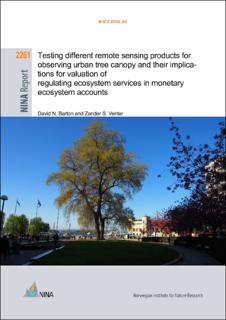| dc.contributor.author | Barton, David N. | |
| dc.contributor.author | Venter, Zander S. | |
| dc.date.accessioned | 2023-02-17T16:46:46Z | |
| dc.date.available | 2023-02-17T16:46:46Z | |
| dc.date.issued | 2023 | |
| dc.identifier.isbn | 978-82-426-5058-0 | |
| dc.identifier.issn | 1504-3312 | |
| dc.identifier.uri | https://hdl.handle.net/11250/3052111 | |
| dc.description.abstract | Barton, D.N. & Venter, Z.S. 2023. Testing different remote sensing of urban tree canopy and implications for valuation of regulating ecosystem services in monetary ecosystem accounts. NINA Report 2261. Norwegian Institute for Nature Research
This report assesses regulating ecosystem services (ES) from urban trees in an accounting pilot area in a subset of Oslo’s built zone for which different remote sensing data were available (Ter-raSAR-X, Sentinel-1, Sentinel-2, LiDAR; LiDAR-canopy segmentation. We tested ecosystem service estimates derived from these sources of remote sensing data. We used i-Tree Eco to model ecosystem services from individual trees. We used a non-parametric Bayesian network to generalize the regulating services calculated by i-Tree Eco for municipal trees managed by Oslo’s Urban Environment Agency, to all trees in the accounting study area. For 108 000 tree canopy objects within the study area, we find that monetary estimates for carbon storage vary between 77 – 176 million NOK, and annual flows of carbon sequestration, air pollution mitigation and run-off regulation vary between 6 – 11 million NOK / year. The variation in these estimates is explained by two factors: (i) the difference in the remote sensing data sources that are used to identify tree canopy heights, and (ii) the increasing overestimation of canopy area with a de-creasing spatial resolution of remote sensing data. For future urban ecosystem accounts, we recommend building an emulation model for value generalization purposes using a parametric regression model, to avoid the loss of precision due to the discretization of the data required by the non-parametric approach of Bayesian Networks used in this study. I-Tree Eco is not open source model code. Testing the open-source INCA-Tool (Buchhorn et al., 2022) on bespoke LiDAR data of vegetation structure collected by municipalities seems a promising way forward. Given the periodicity of LiDAR data updating in Oslo of approximately 4 years, and the corre-spondence with the municipal planning cycle, we would recommend that any urban ecosystem physical accounts for Oslo are updated every 4 years as well. In future research, optimal report-ing periods for change detection could also be evaluated. | en_US |
| dc.description.abstract | Barton, D.N. & Venter, Z.S. 2023. Testing different remote sensing of urban tree canopy and implications for valuation of regulating ecosystem services in monetary ecosystem accounts. NINA Report 2261. Norwegian Institute for Nature Research
Rapporten beregner regulerende økosystemtjenester fra bytrær i et pilotområde innenfor Oslo’s byggesone der vi hadde tilgang til fjernmålingsdata for det samme området (TerraSAR-X, Senti-nel-1, Sentinel-2, LiDAR; LiDAR-trekrone-segmentering). Vi beregnet økosystemtjenester fra enkelt-trær basert på ulike typer fjernmålingsdata ved hjelp av i-Tree Eco modellen. Vi brukte en ikke-parametrisk Bayesiansk nettverksmodell for å generalisere de fysiske økosystemtjenes-tene beregnet på bytrær forvaltet av Oslo Kommunes Bymiljøetat til alle trær i studie-området. For de 108 000 trekrone-objektene vi identifiserte i studieområdet, beregnet vi kroneverdien av karbonlagring til mellom 77 – 176 million NOK totalt, og samlet årlig verdi av karbonopptak, luftrensing og overvannsregulering til mellom 6- 11 millioner NOK/år. Usikkerheten i disse estimatene skyldes to forhold: (i) forskjellen i fjernmålingsdata i identifisering av trekronehøyder, og (ii) økende over-estimering av trekrone-areale ved reduksjon i romlig oppløsning av ulike fjernmålingsdata. I fremtidige beregninger for bynaturregnskap, anbefaler vi å bruke en parametrisk simuleringsmodell for å generalisere økosystemtjenester fra et utvalg til hele regnskapsområder. Dette vil unngå tap av nøyaktighet som i denne studien skyldes diskretisering av data som gjøres ved å bruke en ikke-parametrisk Bayesiansk modell. I-Tree Eco modellen er ikke åpen-kilde-kode. Uttesting av INCA-Tool modellene (Buchhorn et al., 2022) – en EU-standardisert modellpakke med åpen kildekode for å beregne økosystemtjenester - sammen med kommunale LiDAR data for vegetasjonsstruktur virker lovende. Gitt et omløp hittil på omtrent 4 år på LiDAR data i Oslo, som også samsvarer med periode for kommunevalg, anbefaler vi bytre-regnskap som også oppdateres hvert 4 år. I fremtidig utviklingsarbeid bør man også teste hva som er optimale regnskapsperiode i forhold til deteksjon av endring i trekrone-dekket. | en_US |
| dc.language.iso | eng | en_US |
| dc.publisher | Norwegian Institute for Nature Research (NINA) | en_US |
| dc.relation.ispartofseries | NINA Report;2261 | |
| dc.subject | urban forestry | en_US |
| dc.subject | urban nature | en_US |
| dc.subject | ecosystem accounting | en_US |
| dc.subject | uncertainty | en_US |
| dc.subject | iTree Eco | en_US |
| dc.subject | ecosystem services | en_US |
| dc.subject | LiDAR | en_US |
| dc.subject | TerraSAR-X | en_US |
| dc.subject | Sentinel-2 | en_US |
| dc.subject | byskog | en_US |
| dc.subject | bynatur | en_US |
| dc.subject | naturregnskap | en_US |
| dc.subject | usikkerhet | en_US |
| dc.subject | økosystemtjenester | en_US |
| dc.subject | fjernmåling | en_US |
| dc.title | Testing different remote sensing products for observing urban tree canopy and their implications for valuation of regulating ecosystem services in monetary ecosystem accounts | en_US |
| dc.type | Research report | en_US |
| dc.rights.holder | © Norwegian Institute for Nature Research. The publication may be freely cited where the source is acknowl-edged | en_US |
| dc.source.pagenumber | 42 | en_US |
